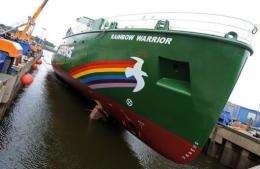Enfants terribles of the environment hit middle age

We sort our rubbish. We recycle our rainwater. We worry about depleted oceans, ravaged rainforests, threatened species.
If we fly abroad, buy a car, crank up the heating or air-conditioning -- or even purchase bottled water -- we may think about how we add to the greenhouse effect.
These reflexes are now anchored among consumers in many parts of the world.
Yet 40 years ago, when environmentalism was limited to a tribe of academics and quirky visionaries, such actions would have triggered bewilderment, even a laugh.
Back then, whales were slaughtered commercially on a massive scale.
France and China conducted nuclear tests in the atmosphere.
People sprayed their armpits with deodorants that gobbled up Earth's ozone layer.
Oil was so cheap that the term "gas guzzler" had not even been invented, any more than "carbon footprint."
Yet it was also in September 1971 that the blithe belief in Earth as a planet of boundless resources began to shrink, thanks in large part to green activism.
Born within days of each other, Greenpeace and Friends of the Earth International launched a mix of grassroots campaigning, provocative or humorous stunts or civil disobedience, jolting a movement that until then had been sedate.
"The 1960s and 70s were the beginning of large-scale environmental breakdown, and people were aware of it," author Rex Weyler, also co-founder of Greenpeace International, said in a phone interview with AFP.
In 1985, Greenpeace's vessel, the Rainbow Warrior, was blown up by French agents to prevent it nearing the Mururoa test site in the South Pacific.
The scandal propelled Greenpeace to global prominence, a status strengthened the following year by the Chernobyl disaster.
Today, with a presence in 43 countries, 2.8 million members or donors, and a budget last year that rose 15 percent to 226 million euros (310 million dollars), it is a force that few governments or corporations can readily ignore.
Its 1,200 staff range from "direct action" activists to scientific researchers, policy wonks and iPad-clutching smoothies who twist the arms of policymakers, executives and journalists. Friends of the Earth boasts 76 member groups and two million members.
The list of exploits is long.
Green militancy helped seal the Montreal Protocol to protect the ozone layer, blocked Monsanto's transgenic seeds in Europe, made Shell scrap plans to dump a disused oil rig in the sea and pressured Nestle over palm oil sourced from Indonesian rain forests (www.youtube.com/watch?v=QV1t-MvnCrA).
But such clout is strongest in Europe and North America and is far weaker in Asia and Africa, where the environment is fast degrading.
And on climate change -- where the biggest bucks are at stake -- campaigning "has met with a bloody nose," as a veteran UN observer put it.
The NGOs agitated massively for a worldwide treaty at the Copenhagen Summit in December 2009. They were stunned when the summit became a fiasco, leaving climate change in a limbo that is unchanged today.
"The strategy for Copenhagen was really 'Copenhagen or bust'," Paul Horsman of the London-based Global Campaign for Climate Action told AFP in June. "Well, Copenhagen bust."
After celebrating its 40th birthday on Thursday, Greenpeace next month launches Rainbow Warrior III -- a tailor-made engine-assisted sailing ship, complete with helicopter pad and accommodation for 32 eco-warriors.
Like the grey-haired man who buys a Porsche, is this a luxury purchase to boost the testosterone levels, to remind a middle-aged organisation of its youth?
One such critic is Paul Watson. He helped launch Greenpeace but split to set up the Sea Shepherd Conservation Society, which is claiming more and more successes in confronting Japan's whalers on the high seas.
In his view, the big NGOs have ignored the crisis of human over-population and become gentrified, cosying up to politicians who have no interest in fixing enviroment problems as it would cost them their career to do so.
"Anger, which was a very important part of (the environment movement), has left it," Watson said in an interview.
Greenpeace, he quipped, "are the Avon Ladies of the environmental movement. They're just knocking on doors and asking for money."
Greenpeace retorts that it still uses non-violent "direct action," but in a mix of smart campaigning, with viral videos, petitions and pressure on culprit corporations and lobbying for policy change.
Asked to look back, Greenpeace's Mike Townsley, said: "The last 40 years haven't been without benefit or purpose. But the failure is that we are still here. It shows that the job's not done yet."
(c) 2011 AFP



















